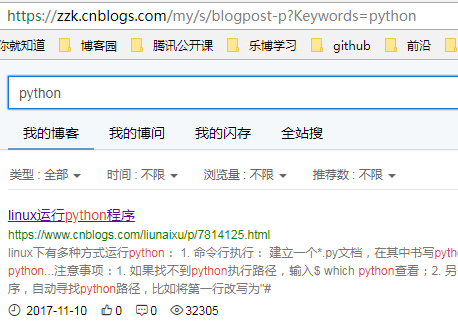python接口自动化1-发送get请求
前言
requests模块,也就是老污龟,为啥叫它老污龟呢,因为这个官网上的logo就是这只污龟,接下来就是学习它了。
一、环境安装
1.用pip安装requests模块
>>pip install requests

二、get请求
1.导入requests后,用get方法就能直接访问url地址,如:https://www.cnblogs.com/liunaixu,看起来是不是很酷
2.这里的r也就是response,请求后的返回值,可以调用response里的status_code方法查看状态码
3.状态码200只能说明这个接口访问的服务器地址是对的,并不能说明功能OK,一般要查看响应的内容,r.text是返回文本信息

1 2 3 4 5 6 7 8 9 10 11 | # @Author:lsj# @version V1.0# -*- coding:UTF-8 -*-import requests# 请求我公司后台网站首页r = requests.get("http://daxue.qysxy.com.cn/admin/static/front/html/index.html")print(r.text)print(r.status_code) |
三、params
1.再发一个带参数的get请求,如在博客园搜索:python,url地址为:https://zzk.cnblogs.com/my/s/blogpost-p?Keywords=python

2.请求参数:Keywords=python,可以以字典的形式传参:{"Keywords":"python"}
3.多个参数格式:{"key1": "value1", "key2": "value2", "key3": "value3"}
四、content
1.百度首页如果用r.text会发现获取到的内容有乱码,因为百度首页响应内容是gzip压缩的(非text文本)

2.如果是在fiddler工具乱码,是可以点击后解码的,在代码里面可以用r.content这个方法,content会自动解码 gzip 和deflate压缩

五、response
1.response的返回内容还有其它更多信息
-- r.status_code #响应状态码
-- r.content #字节方式的响应体,会自动为你解码 gzip 和 deflate 压缩
-- r.headers #以字典对象存储服务器响应头,但是这个字典比较特殊,字典键不区分大小写,若键不存在则返回None
-- r.json() #Requests中内置的JSON解码器
-- r.url # 获取url
-- r.encoding # 编码格式
-- r.cookies # 获取cookie
-- r.raw #返回原始响应体
-- r.text #字符串方式的响应体,会自动根据响应头部的字符编码进行解码
-- r.raise_for_status() #失败请求(非200响应)抛出异常




【推荐】国内首个AI IDE,深度理解中文开发场景,立即下载体验Trae
【推荐】编程新体验,更懂你的AI,立即体验豆包MarsCode编程助手
【推荐】抖音旗下AI助手豆包,你的智能百科全书,全免费不限次数
【推荐】轻量又高性能的 SSH 工具 IShell:AI 加持,快人一步
· 基于Microsoft.Extensions.AI核心库实现RAG应用
· Linux系列:如何用heaptrack跟踪.NET程序的非托管内存泄露
· 开发者必知的日志记录最佳实践
· SQL Server 2025 AI相关能力初探
· Linux系列:如何用 C#调用 C方法造成内存泄露
· 震惊!C++程序真的从main开始吗?99%的程序员都答错了
· 【硬核科普】Trae如何「偷看」你的代码?零基础破解AI编程运行原理
· 单元测试从入门到精通
· 上周热点回顾(3.3-3.9)
· Vue3状态管理终极指南:Pinia保姆级教程